Nikon Nikkor AF-S DX Micro 85 mm f/3.5G ED VR
3. Build quality and image stabilization
The Nikkor’s focal length is the longest here but this device is also the slowest. It compares very unfavourably with the Tamron, the fastest in this class. The Nikkor and the Canon prevail over the Tamron for a change because they are physically lighter and they boast an ultrasonic autofocus. Good f/2.0 fastness entails big elements and they are heavy.
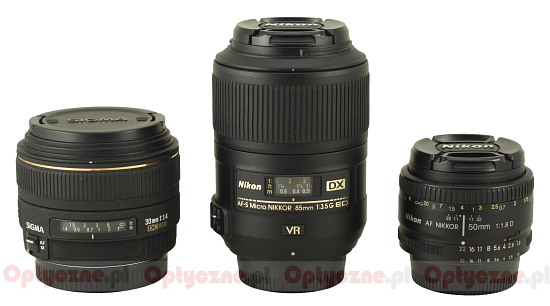 |
Please Support UsIf you enjoy our reviews and articles, and you want us to continue our work please, support our website by donating through PayPal. The funds are going to be used for paying our editorial team, renting servers, and equipping our testing studio; only that way we will be able to continue providing you interesting content for free. |
- - - - - - - - - - - - - - - - - - - - - - - - - - - - - - - - - - - - - - - - - - - - - - - -
The Nikkor AF-S DX Micro 85 mm f/3.5G ED VR, makes a very good first impression. Its build quality and solidity is beyond reproach. The lens starts with a metal mount inside which you can find a rear element, with a diameter of less than 2 cm. It is hidden by about 1.5 cm inside the barrel and it doesn’t change its position during focusing.
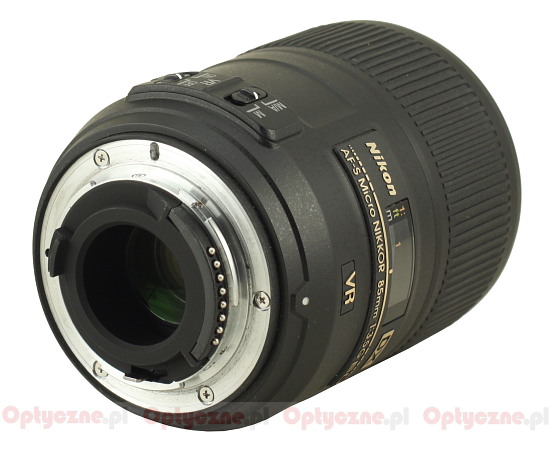 |
Behind the mount, already on the black barrel, we see the VR symbol meaning optical stabilization of image was implemented here; on the left there is an M-A/M switch, to set the right focus mechanism’s mode, and a VR ON/OFF stabilization switch.
 |
Further on, in the direction of the front element, we find a plate with the name and parameters of the lens and a distance scale under a window, expressed in metres and feet. On the other side of the lens Nikon gives its name once again, informing us also about the diameter of the filters and the fact that the instrument was made in China.
Most of the barrel is occupied by a manual focus ring, almost 4 cm wide. In the case of a macro lens it is an important feature as it must allow you very precise settings. The manufacturer did a good job here – the ring is difficult to fault as it is a joy to use. Running through the scale takes a turn of almost 180 degrees.
At the end of the lens there is a front element with a rather small diameter of less than 3 cm. It doesn’t move and is surrounded by a non-rotating filter thread, 52 mm in diameter.
Inside the lens there are 14 elements positioned in 10 groups. One element was made of low-dispersion ED glass. The aperture has nine diaphragm blades and can be closed down to f/32.
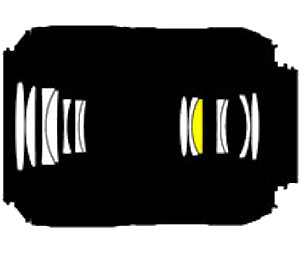
It’s worth remembering that when you pass to the minimum focus distance the mutual positions of the elements change in such a way that the effective focal length is shorter than the value of 85 mm, given for infinity – it happens because of the closed optical construction and internal focusing design.
The buyer gets both caps, a hood and a flexible lens pouch as accessories, supplied with the lens.
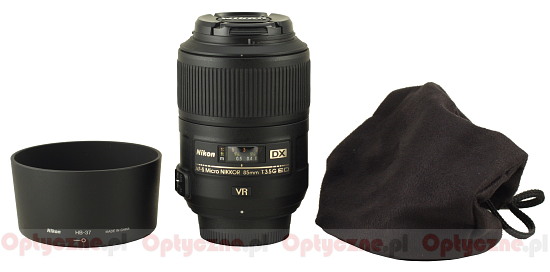 |
Stabilization
The producer claims that the stabilization of the lens allows you to apply exposure times 16x longer than it would be possible otherwise. The efficiency of the mechanism is supposed to be 4 EV. We decided to check that claim by taking several dozen photos for every exposition value ranging from 1/100 to 1/2 of a second with the stabilization switched on and off. Then we calculated the number of blurred photos and we presented that percentage as an exposure time function graph, expressed in EV (where 0 EV is the equivalent of 1/80 of a second)
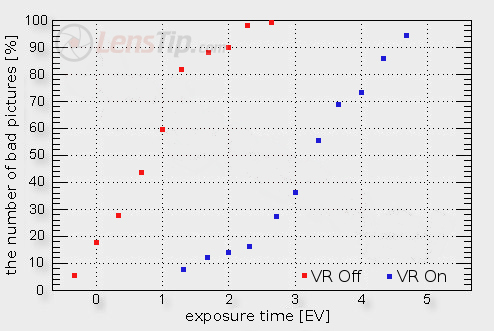
As you see the maximum distance between both graphs amounts to nearly 3 EV so we don’t reach these declared 4 EV. Taking into account the fact that we deal here with an low-end amateur device, though, the result is still relatively good.






